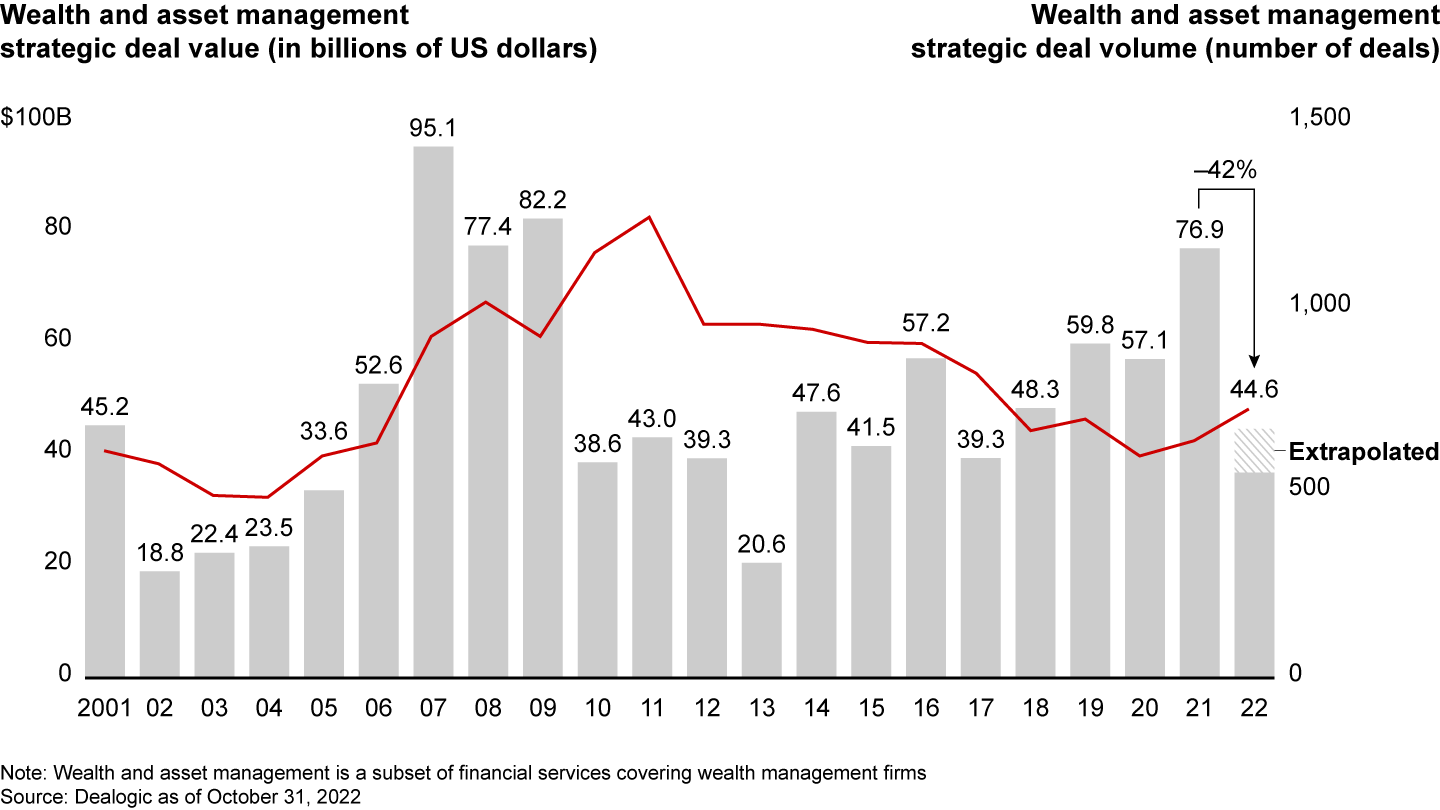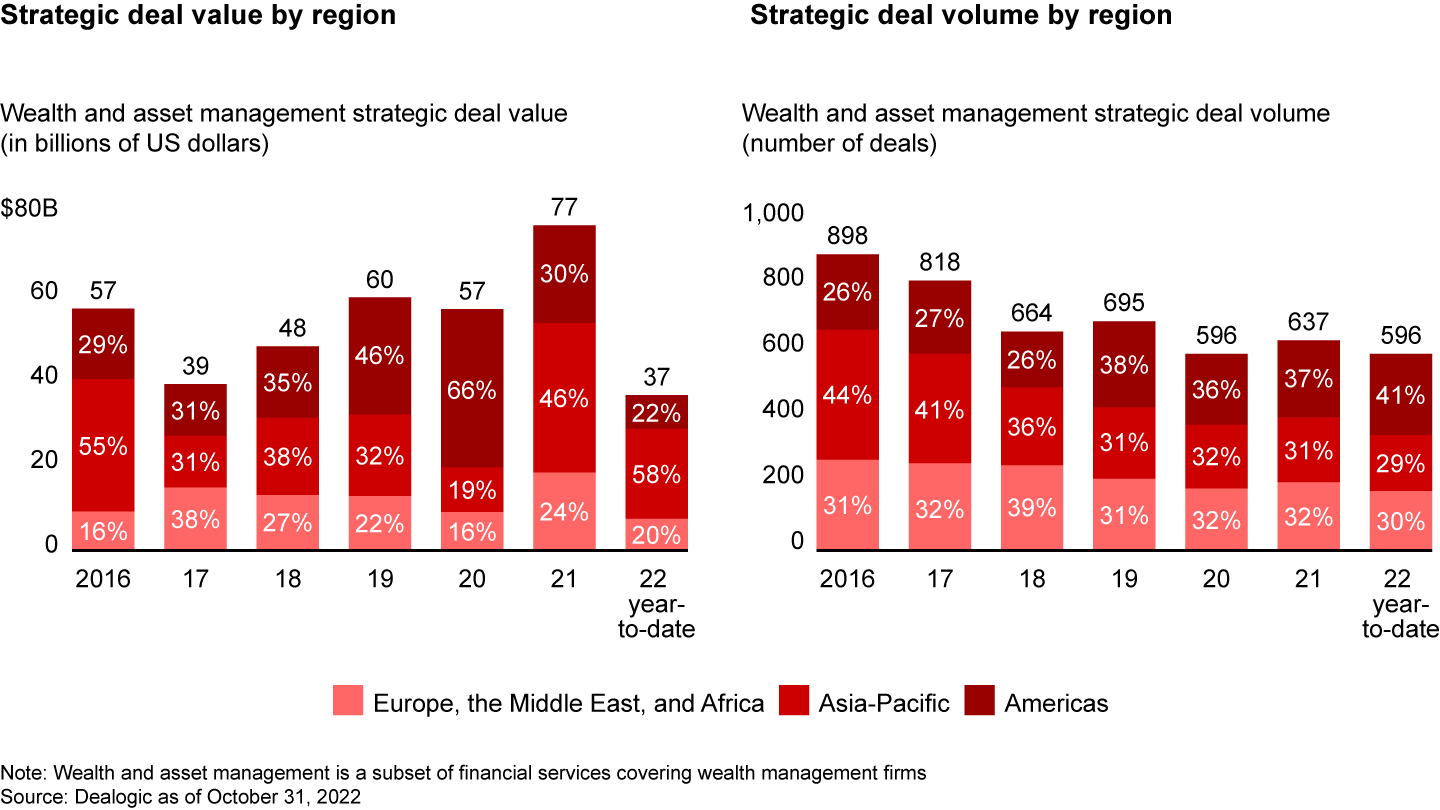M&A Report
 }
}
At a Glance
- Wealth and asset management will undergo a dramatic evolution by 2030, and firms will turn to both scale and scope M&A to seize growth opportunities.
- Wealth and asset management deal value for 2022 is projected to decline by 42% from 2021’s record levels, mostly driven by smaller average deal values.
- We expect to continue to see a smaller share of deals valued at greater than $1 billion.
- We also expect a rise in scope deals, especially those made to gain digital capabilities, expand offerings and ecosystems, and continue vertical integration.
This article is part of Bain's 2023 M&A Report.
Wealth management and asset management companies are facing such significant disruption that by 2030—with new customers, new delivery models, new offerings, new ways of working, and new economics—both financial services sectors will be virtually unrecognizable. Bain’s research into the evolution of the sectors determined that there is a $250 billion growth opportunity in wealth management by 2030 and that scale M&A will ultimately play a critical role as the largest players will outpace the market and be able to invest in the digital and analytical capabilities to offer differentiated services. Asset managers also will rely on scale deals for distribution/client coverage models and cost leadership, to build winning offerings, and to establish the ecosystems and platforms for a changing sector.
Both financial services sectors will be virtually unrecognizable by 2030.
But even though scale deals will likely determine the shape of the wealth and asset management businesses in 2030, the year ahead will likely be one defined by smaller scope deals—a trend that began in mid-2022 as interest rates climbed, making deals valued at greater than $1 billion more expensive. Additionally, geopolitical and macroeconomic uncertainty on a global level will likely continue to hold back many large investments.
While 2021 set a 10-year record for global M&A activity in wealth and asset management, the cooldown that started in June 2022 is projected to lead to a 42% drop in deal value but an increase of 13% in deal volume by the end of 2022, reflecting a smaller average size of deals (see Figure 1).

The share of strategic deal volume by region stayed relatively stable compared with the previous year, though a larger share (58% vs. 46%) of the strategic deal value has been coming from the Asia-Pacific region, where a large share of 2022's deals valued at greater than $1 billion took place (see Figure 2).

Many of the deals in Europe were aimed at entering and consolidating the UK market, including one of the few deals valued at greater than $1 billion in 2022, RBC’s $2.1 billion acquisition of Brewin Dolphin. In the Americas, deals valued at greater than $1 billion saw players acquiring capabilities/scale in (digital) trading/brokerage to strengthen holistic, digitally enabled wealth and asset management offerings. That was the aim of Itaú Unibanco’s acquisition of 50.1% of a fully digital and cloud-based brokerage in Brazil. In North America, 2022 also saw the continued rollup of the registered investment adviser and independent adviser market.
The years ahead
Looking into the short- to medium-term future, we expect M&A activity to persist, but it will likely look different given the market downturn. We anticipate fewer large deals for scale, both in wealth and asset management—that’s what happened in the 2009 recession and what has already been observed during the second half of 2022. But there’s an exception. We expect the strongest companies to capitalize on attractive scale investment opportunities as the downturn further increases the gap between winners and losers. In Bain’s M&A Practitioners’ 2023 Outlook Survey, more than 50% of surveyed practitioners across the financial services industry said that they expect more attractive assets to be available in 2023 compared with 2022.
The downturn will further increase the gap between winners and losers.
The larger share of deals in 2023 are likely to be for scope. In wealth management, players will be looking for targets that can help them grow in different ways from scale acquisitions. For example, human-enriched, digitally enabled delivery models will prevail in wealth management, and it will be M&A that becomes the catalyst for ultimate success in those areas. Current valuation levels provide attractive opportunities for strategic buyers with a long-term investment mindset (fintech valuations dropped by about 50% between May 2021 and June 2022). Additionally, M&A for digital capabilities and digitally enabled advisory models will enhance adviser productivity. That, in turn, will be a key enabler to achieving scale over the medium term.
Similarly, we anticipate an uptick in offering-related and tech platform–related deals. For example, as client demand continues to increase for alternatives and private market investments, we expect wealth and asset management companies to pursue targets or strategic partners in this space. That was the objective of AllianceBernstein’s 2022 acquisition of CarVal Investors, a global private alternative investment manager with about $15 billion in assets under management. When Finnish wealth and asset manager Evli merged with EAB, the Finnish asset management and investment services company, it was able to offer an even more extensive range of alternatives (as well as digital service solutions and personnel fund services).
Wealth management clients will increasingly ask for more holistic advice across an expanding range of issues such as estate planning, taxes, and accounting, so we’ll likely see more interest from companies in acquiring these capabilities to round out their offerings (often with a tech angle, which will enable these capabilities to be deployed at scale).
In addition, we expect to see a growth route materialize with the convergence of wealth management and asset management—a deeper vertical integration of the value chain. Goldman Sachs moved in this direction in 2022 when it announced it would internally unify its asset and wealth management businesses back together under one roof. Other companies have been turning to M&A to enable such vertical integration. For example, Schroders invested in Benchmark Capital in 2016 and then bought remaining minority interest in 2021 as well as a series of independent financial advisers, such as Redbourne Wealth Management in early 2022 (which it purchased through Benchmark Capital).
The long-term view
Between now and 2030, there also will be scale activity for wealth management companies. As the largest wealth managers outpace the market, scale benefits will become even more apparent since players will have to make significant investments in tech and data/analytics to provide differentiated client experiences. When a company shifts from a traditional to a digitally enabled wealth management model, returns to scale can be up to 35% higher (because of lower variable costs in a digitally enabled model). To achieve that scale, companies will turn to M&A for consolidation. For smaller players, wealthtechs will serve as platforms to capture benefits from virtual scale, enabling them to compete, but not to differentiate, on technology.
For asset managers, we see two winning models for the future: scale leaders (e.g., BlackRock as a passive scale leader, Amundi as an active scale leader) and differentiated players (e.g., Partners Group, Wellington Management). M&A continues to be a key source of growth and critical scale for both models as there are high-value picks to be made. It will also enable the establishment of platforms centered around specific product offerings, client segments, geographies—or a multiboutique approach.
Wealth and asset management companies hoping to capture both the near- and long-term future opportunities need to proactively pursue an M&A pipeline, screening for both the scope deals that will help them differentiate their business and the scale deals that will help them become industry leaders.

